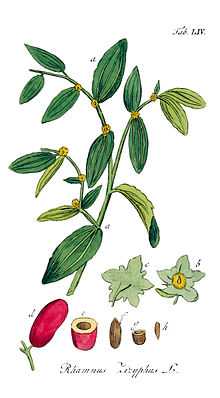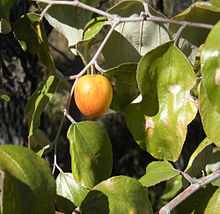Ziziphus
| Ziziphus | |
|---|---|
 | |
| Ziziphus jujuba, by Adolphus Ypey. | |
| Scientific classification | |
| Kingdom: | Plantae |
| (unranked): | Angiosperms |
| (unranked): | Eudicots |
| (unranked): | Rosids |
| Order: | Rosales |
| Family: | Rhamnaceae |
| Tribe: | Paliureae |
| Genus: | Ziziphus Mill., 1768 |
| Type species | |
| Ziziphus jujuba Mill.[1] | |
| Species | |
|
See text | |
| Synonyms | |
|
Condaliopsis (Weberb.) Suess. | |
Ziziphus /ˈzɪzɨfəs/[3] is a genus of about 40 species of spiny shrubs and small trees in the buckthorn family, Rhamnaceae, distributed in the warm-temperate and subtropical regions throughout the world. The leaves are alternate, entire, with three prominent basal veins, and 2–7 cm (0.79–2.76 in) long; some species are deciduous, others evergreen. The flowers are small, inconspicuous yellow-green. The fruit is an edible drupe, yellow-brown, red, or black, globose or oblong, 1–5 cm (0.39–1.97 in) long, often very sweet and sugary, reminiscent of a date in texture and flavour.
Overview
The generic name is derived from zizfum or zizafun, the Persian word for Z. lotus.[4] They are Rhamnaceae, near to the Buckthorn genus.
Ecology
Ziziphus species are used as food plants by the larvae of some Lepidoptera species including Bucculatrix zizyphella, which feeds exclusively on the genus, and Endoclita malabaricus.
Well known species includes Z. jujuba (Jujube), Z. spina-christi from southwestern Asia, Z. lotus from the Mediterranean region, and Ber (Ziziphus mauritiana), which is found from western Africa to India. Ziziphus joazeiro grows in the Caatinga of Brazil. Ziziphus celata is listed as an endangered species in the United States.
The fruits are an important source for birds, that eat the whole fruit and regurgitate seeds intact, expanding the seeds in the best conditions for germination (ornitochory). Secondly, the seed dispersal is carried out by mammalians or fishes. The fruit is energy-rich because of the large amount of sugar it contains. It is cultivated and eaten fresh, dry, and in jam. They also get added as a base in meals and in the manufacture of candy. The leaves can be either deciduous or evergreen depending on species, and aromatic.
They are temperate or tropical plants, having a great range. They are most abundant in annual average temperatures between 12 and 35°C, minimum winter temperatures not lower than -2 °C. Prefers locations with a high temperature coupled with humidity. They require a deep soil, fresh, soft, siliceous-calcareous nature or limestone-clay-silica-clay and subsurface permeable, with pH between 5.5 and 7.8. they not grow well on excessively sandy or clay soils which may be affected by standing water, the plants acquire a limited development. Many species are very sensitive to drought, and if the land is excessively dry and of calcareous nature, may resent the lack of moisture. At the slightest drought is frequent premature fruit drop. Ziziphus has several relict species living in temperate areas. The species can not enduring the bad winter, from temperate continental climate.
The ecological requirements of the genus, are mostly those of vigorous species with a great ability to populate the habitat that is conducive. This genus is adapted mostly to high rainfall and humidity, but some species are deciduous living in mediterranean humid climate. The deciduous Ziziphus species lose all of their leaves for part of the year depending on variations in rainfall. In deciduous tropical species, leaf loss coincides with the dry season in tropical, subtropical and arid regions. They grow mostly in tropical forests but has also been found in stubbles, pastures, in the coastal ranges, tropical mountain areas and interior in wet areas to dry regions. The family is distributed throughout tropical, subtropical areas, and cloud forest.
The differences are ecological adaptations to different environments over a relatively dry-wet climate. Species in less humid environment are smaller or less robust, with less abundant and thinner foliage and have oleifera cells that give trees with a more fragrant aroma.
Uses
In traditional Chinese medicine (TCM), suan zao ren (Ziziphus spinosa) is considered to be sweet and sour in taste, and neutral in action. It is believed to nourish the heart yin, augment the liver blood, and calm the spirit (TCM medical terms). It is used to treat irritability, insomnia and heart palpitations.
Mythology
The mythological lotus tree which occurs in Homer's Odyssey is often equated with Z. lotus, though the date palm is also a possible candidate.
Selected species
|
|
Fossil species
- † Ziziphus hyperboreus Heer (Greenland, Eocene fossil)
- † Ziziphus wyomingianisBerry (Tipperary, Wind River Basin Wyoming, USA, Eocene fossil)[12]
- † = Extinct
Gallery
-

Ziziphus jujuba foliage
-
Dried fruits (azufaifas) in southern Spain of Ziziphus jujuba
-

Azufaifas from Almería
-

Ziziphus oenoplia in Shamirpet, Rangareddy district, Andhra Pradesh, India.
-

Ziziphus oenoplia in Shamirpet, Rangareddy district, Andhra Pradesh, India.
-
_in_Vanasthalipuram%2C_Hyderabad%2C_AP_W_IMG_9259.jpg)
Ziziphus xylopyrus in Hyderabad, India.
-
_in_Vanasthalipuram%2C_Hyderabad%2C_AP_W_IMG_9256.jpg)
Ziziphus xylopyrus in Hyderabad, India.
-
_in_Vanasthalipuram%2C_Hyderabad%2C_AP_W_IMG_9255.jpg)
Ziziphus xylopyrus in Hyderabad, India.
-
Persian Zizyphus in Iran
References
- ↑ "Ziziphus Mill.". TROPICOS. Missouri Botanical Database. Retrieved 31 January 2013.
- ↑ "Ziziphus Mill.". Germplasm Resources Information Network. United States Department of Agriculture. 2004-02-10. Retrieved 2009-10-01.
- ↑ Sunset Western Garden Book, 1995:606–607
- ↑ Quattrocchi, Umberto (2000). CRC World Dictionary of Plant Names. 4 R-Z. Taylor & Francis US. p. 2876. ISBN 978-0-8493-2678-3.
- ↑ "Query Results for Genus Ziziphus". IPNI . Retrieved August 7, 2009.
- ↑ "GRIN Species Records of Ziziphus". GRIN. USDA . Retrieved 2010-10-16.
- ↑ "Classificação segundo a Flora brasiliensis" (in Portuguese). Flora brasiliensis . Retrieved August 7, 2009.
- ↑ "Ziziphus species list". Flora of China. EFloras . Retrieved September 7, 2009.
- ↑ The Biodiversity Committee of the Chinese Academy of Sciences (eds.) (2008). "Genus Ziziphus". Beijing, China: Catalogue of Life China: 2008 Annual Checklist China . Retrieved September 9, 2009.
- ↑ "Flora Europaea: Ziziphus query results". Royal Botanic Garden Edinburgh . Retrieved September 7, 2009.
- ↑ "Ziziphus". Integrated Taxonomic Information System. Retrieved 2010-03-08.
- ↑ Geological Survey professional paper, Issue 165: Shorter Contributions to General Geology. US Govt. Printing Office. 1930. p. 73. Retrieved May 28, 2011.
| Wikispecies has information related to: Ziziphus |
| Wikimedia Commons has media related to Ziziphus. |



